From the Open-Publishing Calendar
From the Open-Publishing Newswire
Indybay Feature
Stanford Community Speaks Out Against Animal Experiments
Stanford students and community members protest use of tens of thousands of animals in Stanford labs.
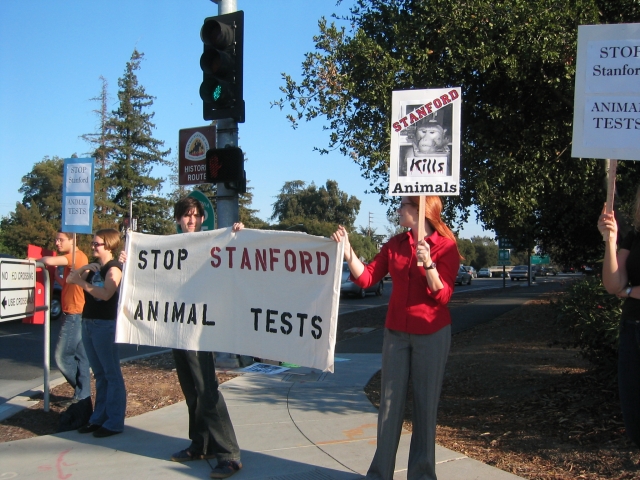
Bearing signs saying “Liberate Primates” and “Stanford Kills Animals,” Stanford University graduate students, undergraduates, law students, and community members protested the use of animals in experiments at Stanford’s Research Animal Facility (RAF) on Friday, October 21.
During a busy Friday rush hour that coincided with Stanford’s “Alumni Weekend,” the activists, members of Animal Rights on the Farm (ARF!), convened on El Camino Real, a major thoroughfare bordering Stanford University in Palo Alto. As passing vehicles honked enthusiastically in approval of the protest, the activists waived signs and distributed leaflets alerting drivers and pedestrians to the animal experimentation conducted on campus. The demonstration was held in commemoration of National Primate Liberation Week, and follows a recent on-campus press conference by Michael Budkie, executive director of Stop Animal Exploitation Now (SAEN). Budkie presented his group’s findings on animal research at Stanford. SAEN’s report details the use of hundreds of primates at the RAF, which ranks 21st nationally in terms of federal research dollars received.
Word of Friday’s demonstration reached some Stanford researchers. Several of the campus’s science buildings were closed early on Friday because of the protest. An email was sent to biology students notifying them of the closure, stating, “Due to a protest against research involving animals that has begun on campus, we have been advised to lock the Lokey building early today. The doors will automatically lock at 3:15.” According to another student, all the other biology buildings were also locked and were being patrolled by police officers. “We had no plans to protest at or near these buildings, so we’re a bit confused by this over-reaction. We also find it troubling that some Stanford researchers are threatened by free speech on campus,” said ARF member and Stanford Law School student Matthew Liebman. This is the third time the Stanford police have responded to peaceful and legal animal rights events, according to Liebman. A Stanford police vehicle with a windshield-mounted video camera also passed the protest on four separate occasions.
ARF! says it will continue to hold demonstrations against animal experimentation at Stanford until the administration agrees to its demands for transparency and accountability for animal tests conducted at Stanford. ARF! has submitted a letter to the University administration asking for a meeting to discuss animal research on campus.
According to a report (http://www.all-creatures.org/saen/res-fr-ca-su-aphis-2002.html) filed by Stanford in 2002 with the US Department of Agriculture (the agency charged with implementing the Animal Welfare Act), Stanford used the following animals for experiments: 32 dogs, 172 hamsters, 376 rabbits, 323 nonhuman primates, 110 sheep, 541 pigs, 2 goats, 9 ferrets and 471 gerbils (2,036 total animals). Because USDA does not require reporting on mice, rats, birds, and amphibians, the actual number of animals used at Stanford is much higher. Nationwide, rats and mice make up approximately 95% of animals used in research. Using this statistic, ARF estimates that Stanford’s RAF uses as many as 40,000 animals. The Research Animal Facility at Stanford University received over $146 million in federal funding in 2003 for animal experimentation, ranked 21st in the country.
Animal Rights on the Farm (ARF) criticizes, among other experiments, the following: one Stanford researcher systematically deprives mice, rats, and monkeys of sleep to determine the relationship between sleep deprivation, body weight, and energy expenditure (Role of Hypocretin in Metabolic Effects of Sleep Loss, NIH Grant #5R01MH073435-02); another separates infant primates from their mothers to test the resultant psychological effects (Maternal Availability and Postnatal Brain Development, NIH Grant #5F32MH066537-03); another induces anxiety and fear in parasite-infested rats (Parasite/Host Interactions and the Neurobiology of Fear, NIH Grant #1R21MH070903-01A1); another conducts gene-therapy research on the livers of rats, rabbits, and dogs (Transferring Integrase Technology to Animals, NIH Grant #5R01HL068112-05); another researcher has spent the last 15 years conducting invasive brain-imaging studies, maternal deprivation experiments, and stress studies in squirrel monkeys (Model of Hypercortisolism for Major Depressions, NIH Grant #5R01MH047573-14).
ARF has also gleaned the following information from the research facility’s newsletters: the labs’ “animal caretakers” filed over 421 morbidity reports in 2001 (Comparative Medicine News, Jan. 2002); the University maintains a colony of inbred mice, “obtained after 20 or more consecutive generations of brother x sister mating” (Comparative Medicine News, Dec. 1999); RAF has been infested with mites, which cause self-mutilation and “blisters, crusts and warty lumps on the ears, eyes and nose” (Comparative Medicine News, Apr. 2002); the facility’s euthanasia procedures include CO2 gassing, followed in some cases by exsanguination (bleeding to death), cervical dislocation, or decapitation, and “[t]horacotomy (making an incision into the chest cavity) after apparent death from CO2 is widely used as a way to ensure the irreversibility of the procedure.” (Comparative Medicine News, Oct. 2003).
For more information on the campaign against the Research Animal Facility at Stanford University, contact arfstanford [at] yahoo.com.
During a busy Friday rush hour that coincided with Stanford’s “Alumni Weekend,” the activists, members of Animal Rights on the Farm (ARF!), convened on El Camino Real, a major thoroughfare bordering Stanford University in Palo Alto. As passing vehicles honked enthusiastically in approval of the protest, the activists waived signs and distributed leaflets alerting drivers and pedestrians to the animal experimentation conducted on campus. The demonstration was held in commemoration of National Primate Liberation Week, and follows a recent on-campus press conference by Michael Budkie, executive director of Stop Animal Exploitation Now (SAEN). Budkie presented his group’s findings on animal research at Stanford. SAEN’s report details the use of hundreds of primates at the RAF, which ranks 21st nationally in terms of federal research dollars received.
Word of Friday’s demonstration reached some Stanford researchers. Several of the campus’s science buildings were closed early on Friday because of the protest. An email was sent to biology students notifying them of the closure, stating, “Due to a protest against research involving animals that has begun on campus, we have been advised to lock the Lokey building early today. The doors will automatically lock at 3:15.” According to another student, all the other biology buildings were also locked and were being patrolled by police officers. “We had no plans to protest at or near these buildings, so we’re a bit confused by this over-reaction. We also find it troubling that some Stanford researchers are threatened by free speech on campus,” said ARF member and Stanford Law School student Matthew Liebman. This is the third time the Stanford police have responded to peaceful and legal animal rights events, according to Liebman. A Stanford police vehicle with a windshield-mounted video camera also passed the protest on four separate occasions.
ARF! says it will continue to hold demonstrations against animal experimentation at Stanford until the administration agrees to its demands for transparency and accountability for animal tests conducted at Stanford. ARF! has submitted a letter to the University administration asking for a meeting to discuss animal research on campus.
According to a report (http://www.all-creatures.org/saen/res-fr-ca-su-aphis-2002.html) filed by Stanford in 2002 with the US Department of Agriculture (the agency charged with implementing the Animal Welfare Act), Stanford used the following animals for experiments: 32 dogs, 172 hamsters, 376 rabbits, 323 nonhuman primates, 110 sheep, 541 pigs, 2 goats, 9 ferrets and 471 gerbils (2,036 total animals). Because USDA does not require reporting on mice, rats, birds, and amphibians, the actual number of animals used at Stanford is much higher. Nationwide, rats and mice make up approximately 95% of animals used in research. Using this statistic, ARF estimates that Stanford’s RAF uses as many as 40,000 animals. The Research Animal Facility at Stanford University received over $146 million in federal funding in 2003 for animal experimentation, ranked 21st in the country.
Animal Rights on the Farm (ARF) criticizes, among other experiments, the following: one Stanford researcher systematically deprives mice, rats, and monkeys of sleep to determine the relationship between sleep deprivation, body weight, and energy expenditure (Role of Hypocretin in Metabolic Effects of Sleep Loss, NIH Grant #5R01MH073435-02); another separates infant primates from their mothers to test the resultant psychological effects (Maternal Availability and Postnatal Brain Development, NIH Grant #5F32MH066537-03); another induces anxiety and fear in parasite-infested rats (Parasite/Host Interactions and the Neurobiology of Fear, NIH Grant #1R21MH070903-01A1); another conducts gene-therapy research on the livers of rats, rabbits, and dogs (Transferring Integrase Technology to Animals, NIH Grant #5R01HL068112-05); another researcher has spent the last 15 years conducting invasive brain-imaging studies, maternal deprivation experiments, and stress studies in squirrel monkeys (Model of Hypercortisolism for Major Depressions, NIH Grant #5R01MH047573-14).
ARF has also gleaned the following information from the research facility’s newsletters: the labs’ “animal caretakers” filed over 421 morbidity reports in 2001 (Comparative Medicine News, Jan. 2002); the University maintains a colony of inbred mice, “obtained after 20 or more consecutive generations of brother x sister mating” (Comparative Medicine News, Dec. 1999); RAF has been infested with mites, which cause self-mutilation and “blisters, crusts and warty lumps on the ears, eyes and nose” (Comparative Medicine News, Apr. 2002); the facility’s euthanasia procedures include CO2 gassing, followed in some cases by exsanguination (bleeding to death), cervical dislocation, or decapitation, and “[t]horacotomy (making an incision into the chest cavity) after apparent death from CO2 is widely used as a way to ensure the irreversibility of the procedure.” (Comparative Medicine News, Oct. 2003).
For more information on the campaign against the Research Animal Facility at Stanford University, contact arfstanford [at] yahoo.com.
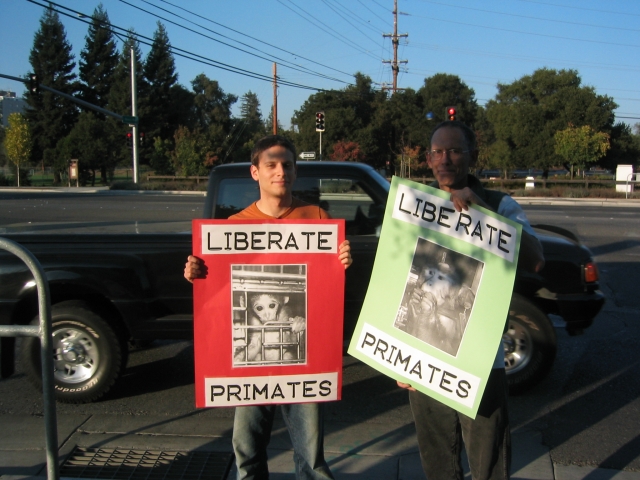
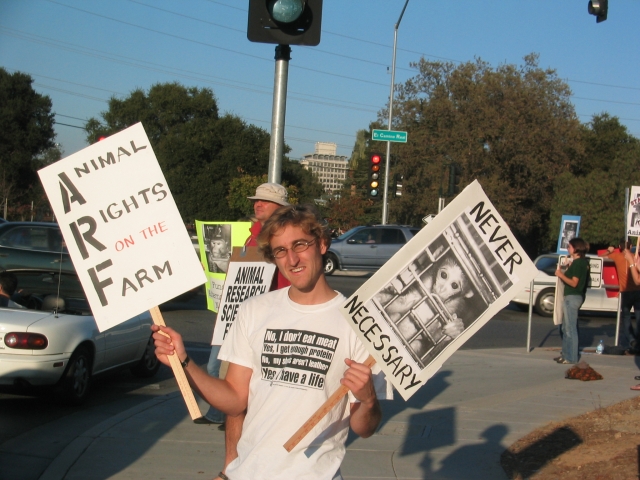
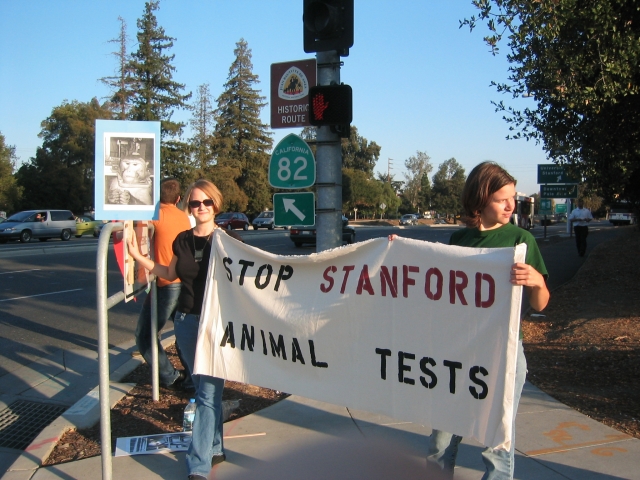
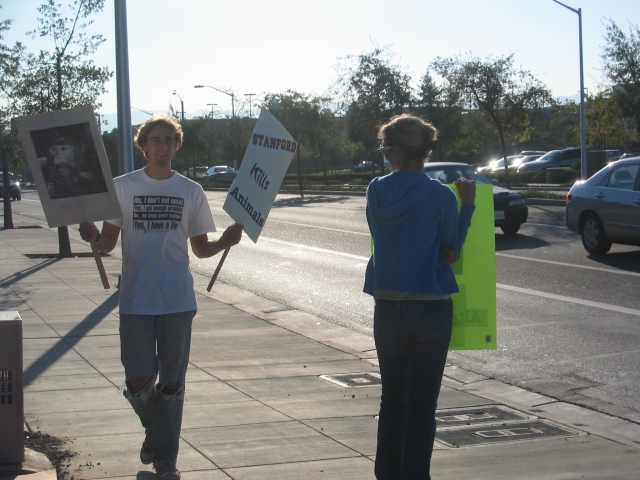
Add Your Comments
Comments
(Hide Comments)
santa clara county sheriffs should not be on a campus.they are intimidating in general.
Thank you for speaking up for the non-human animals used for out-of-date and cruel experiments. We are actively campaining against Covance primate breeding farm near Barcelona, Spain and we have an on-line e-mail form that you may want to sign: http://www.altarriba.org/camarles/MailPrimatesi.htm
Keep up the great work!!!!! (by the way, where did you get a t-shirt like that??? we are all sick-and-tired of the same questions!
For more information:
http://www.altarriba.org
Another location that could be protested is the California National Primate Research Center at UC Davis. The location is a bit out of the way (county road 98 & Hutchinson, isolated from main campus), though there would be good visibilty on campus. Many UCD students are unaware of the torture inflicted on primates just a few miles from their dorms..
Even UCD admits in their 2001 DEIR that non-animal alternative research techniques are an improvement to outdated animal research..
"However, API agrees with what it calls UCD's surprisingly candid admission in its August 31, 2001 Draft Environmental Impact Report (DEIR) that the use of non-animal alternative research techniques is "environmentally superior" to UCD's proposed action of expanding the Primate Center's research and animal breeding programs."
http://www.api4animals.org/1112.htm
Seems like many of the primates at UCD are from the disappearing rainforests of South America. Ironically the tropical rainforest is the same source of many medicinal plants valued by the pharmaceutical corporations for curing diseases. Even though now the pharma corps are profiting from overpriced drugs that alleviate symptoms of nutrition or lifestyle malfunctions (high cholesteral, impotence, depression, etc.) that could be easily prevented by changing lifestyle and nutrition. In some severe cases society may need to adapt itself to form healthier communities, thereby reducing isolation that can contribute to depression. Marcia Angell describes the myth of pharmaceutical corporations as innovative producers of wonder drugs. Remember each "new" drug requires animal tests to be released on the consumer market..
"The industry likes to portray itself as the engine of innovation, but in fact its major products are me-too drugs—minor variations of drugs already on the market. For example, we have six cholesterol-lowering statins on the market right now; we have five SSRI anti-depressants; we have nine ACE inhibitors to treat high blood pressure. If you look at the top-selling drugs on the market right now, most of them are me-too drugs, and the original of these drugs came on the market back in the ‘80s, or even earlier. The companies have been stringing out variations on the themes ever since. The original drugs were usually based on government university research."
http://www.motherjones.com/news/qa/2004/09/09_401.html
The primates held in captivity at UCD for mostly test subjects for pharma corps previously played an important role in rainforest ecosystem biodiversity health by spreading the range of plants through seed digestion and excretion as they hop across the forest canopy. The absence of primates in the rainforest results in smaller habitat ranges of plants and trees, many with medicinal and/or nutritional benefits to humans..
This from the UCD CNPRC website describes their facility and the species of primates housed there..
"The CNPRC houses and cares for approximately 4,700 monkeys. The majority of these monkeys are rhesus macaques, with small populations of cynomolgus monkeys and South American titi monkeys."
http://www.cnprc.ucdavis.edu/pages/about/overview.html
Seems like the pharma corps are not the only interests at UCD primate research. Our very own beloved military researchers are involuntarily testing bioweapons on these helpless primates. Sometimes primates do escape on their own, hope that the escapees aren't the one innoculated with genetically engineered smallpox, eh?
"Put bluntly, the increasing number of stateside bioweapons blunders should come as no surprise. In February 2003, for example, the University of California at Davis (UCD) took a full ten days to inform nearby communities that a rhesus monkey had escaped from its primate-breeding facility. Coincidentally, UCD had been vying for government funds to set up its own "hot zone" biodefense lab which could use primates for biological weapons testing. If that monkey had been infected with ebola, or some other virus, it's unclear when or if the public would have been informed.
At roughly the same time that the monkey ditched UCD, the Pentagon unearthed over 2,000 tons of hazardous biological waste in Maryland, much of it undocumented leftovers of an abandoned germ warfare program. Nearby, the FBI was draining a pond for clues into 2001's anthrax attacks."
http://www.commondreams.org/views05/0414-21.htm
Animals are innocent and do not deserve to be subjected to these cruel and unusual treatments by pharmaceutical corporations and/or the military. Primates belong in their rainforest ecosystem and they will help us more by spreading seeds of plants and trees that may offer future medicine upon discovery..
No mas primate torture at UCD, Ya Basta!!
luna moth
Even UCD admits in their 2001 DEIR that non-animal alternative research techniques are an improvement to outdated animal research..
"However, API agrees with what it calls UCD's surprisingly candid admission in its August 31, 2001 Draft Environmental Impact Report (DEIR) that the use of non-animal alternative research techniques is "environmentally superior" to UCD's proposed action of expanding the Primate Center's research and animal breeding programs."
http://www.api4animals.org/1112.htm
Seems like many of the primates at UCD are from the disappearing rainforests of South America. Ironically the tropical rainforest is the same source of many medicinal plants valued by the pharmaceutical corporations for curing diseases. Even though now the pharma corps are profiting from overpriced drugs that alleviate symptoms of nutrition or lifestyle malfunctions (high cholesteral, impotence, depression, etc.) that could be easily prevented by changing lifestyle and nutrition. In some severe cases society may need to adapt itself to form healthier communities, thereby reducing isolation that can contribute to depression. Marcia Angell describes the myth of pharmaceutical corporations as innovative producers of wonder drugs. Remember each "new" drug requires animal tests to be released on the consumer market..
"The industry likes to portray itself as the engine of innovation, but in fact its major products are me-too drugs—minor variations of drugs already on the market. For example, we have six cholesterol-lowering statins on the market right now; we have five SSRI anti-depressants; we have nine ACE inhibitors to treat high blood pressure. If you look at the top-selling drugs on the market right now, most of them are me-too drugs, and the original of these drugs came on the market back in the ‘80s, or even earlier. The companies have been stringing out variations on the themes ever since. The original drugs were usually based on government university research."
http://www.motherjones.com/news/qa/2004/09/09_401.html
The primates held in captivity at UCD for mostly test subjects for pharma corps previously played an important role in rainforest ecosystem biodiversity health by spreading the range of plants through seed digestion and excretion as they hop across the forest canopy. The absence of primates in the rainforest results in smaller habitat ranges of plants and trees, many with medicinal and/or nutritional benefits to humans..
This from the UCD CNPRC website describes their facility and the species of primates housed there..
"The CNPRC houses and cares for approximately 4,700 monkeys. The majority of these monkeys are rhesus macaques, with small populations of cynomolgus monkeys and South American titi monkeys."
http://www.cnprc.ucdavis.edu/pages/about/overview.html
Seems like the pharma corps are not the only interests at UCD primate research. Our very own beloved military researchers are involuntarily testing bioweapons on these helpless primates. Sometimes primates do escape on their own, hope that the escapees aren't the one innoculated with genetically engineered smallpox, eh?
"Put bluntly, the increasing number of stateside bioweapons blunders should come as no surprise. In February 2003, for example, the University of California at Davis (UCD) took a full ten days to inform nearby communities that a rhesus monkey had escaped from its primate-breeding facility. Coincidentally, UCD had been vying for government funds to set up its own "hot zone" biodefense lab which could use primates for biological weapons testing. If that monkey had been infected with ebola, or some other virus, it's unclear when or if the public would have been informed.
At roughly the same time that the monkey ditched UCD, the Pentagon unearthed over 2,000 tons of hazardous biological waste in Maryland, much of it undocumented leftovers of an abandoned germ warfare program. Nearby, the FBI was draining a pond for clues into 2001's anthrax attacks."
http://www.commondreams.org/views05/0414-21.htm
Animals are innocent and do not deserve to be subjected to these cruel and unusual treatments by pharmaceutical corporations and/or the military. Primates belong in their rainforest ecosystem and they will help us more by spreading seeds of plants and trees that may offer future medicine upon discovery..
No mas primate torture at UCD, Ya Basta!!
luna moth
Demo lookes great! The message is clear!
Also; 'Don't book a Holiday to Hell'.
The holiday destination of Mauritius is one of the world's-largest exporter of monkeys to animal testing labs all across the world. All these animals will suffer and die in agony.
When booking your holiday please boycott Mauritius.
see http://www.gatewaytohell.net
You are all a bunch of posers. If you really cared of about stopping standford from engaging animal cruelty you would end your enrollment with the university and attend a different ivy leauge school that engages in more humane policies. Once stanford notices students with wads of money droping out they will change their tune about animal testing.
Yes, after all, what purpose does it serve? Except to advance medical research and save lives... But a good alternative would be to utilize our immense prison population... perhaps we can come to an agreement?..
We are 100% volunteer and depend on your participation to sustain our efforts!
Get Involved
If you'd like to help with maintaining or developing the website, contact us.
Publish
Publish your stories and upcoming events on Indybay.
Topics
More
Search Indybay's Archives
Advanced Search
►
▼
IMC Network


